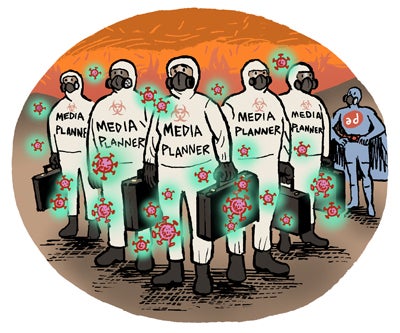What does it feel like to be a media buyer and planner in 2025?
That question launched a fascinating “Ask Me Anything”-style discussion at Cynopsis ScreenShift in New York City on Tuesday. Led by Advertiser Perceptions SVP Erin Firneno, the conversation featured several thought leaders from independent and holdco-owned agencies.
And neither the panel nor the attendees who asked them anonymous questions pulled any punches.
“It feels a little bit like drinking from a firehose,” said Samantha Rose, EVP and strategic investment lead at Horizon Media. “There’s so much to know, and it’s very hard to keep up.”
Beyond just knowing everything (or finding the right experts at the very least), media planners also have to keep their clients well informed, said Tim Hill, chief partnerships officer at IPG Mediabrands’ media buying agency, Initiative.
To top it all off, media buyers also must constantly be thinking about contingency plans for anything that might happen.
The January TikTok ban was a perfect example, said KSM Media VP of Business Leadership Luke Fowler. The ban’s reversal not 12 hours later was the “worst possible thing,” he said, because agencies spent all this time pulling their media buys and then had to change course all over again.
Fortunately, there are ways to make the relationship between media buyers and sellers slightly easier (if you actually listen to the buy side, of course).
Don’t go over the agency’s head (if you can help it)
One anonymous attendee asked for “the best way to structure an org chart for agencies and holding companies,” on the grounds that “it’s getting harder to connect with buyers consistently.”
Some of that difficulty stems from the sell side having much fewer silos to contend with these days than the buy side does, said Rose. As a result, the sell side can be nimbler – and they sometimes don’t want to wait for the agency to catch up.
“There’s nothing more frustrating than when we feel like we get hit by something unexpected, or something goes to our client well before the agency knows about it,” Rose said.
To help cut down on the red tape of talking with agencies, Hill recommended finding trusted partners within the organization who can help you navigate the complexity of their infrastructure and “be thoughtful about who should be speaking for what.”
Don’t expect to rely on AI for everything
However, trusted partners will be harder to come by if agencies forgo hiring entry-level staffers in favor of more AI investments. So, how are agencies currently thinking about when to educate and when to automate?
Automation is coming to knowledge work, just like it did for blue-collar jobs in the 20th century, answered Fowler. Because of that, it’s especially important for agencies to develop a pipeline to cultivate junior talent, or “there isn’t going to be the type of skill development necessary to bring on the next generation of agency leadership.”
When asked how agencies are integrating AI in ways beyond automation, Fowler was a bit more skeptical. “I’m not going in and asking ChatGPT, ‘What should I do with this media plan?’ I think that’s a bit of a stretch,” he said.
As Firneno pointed out, though, a lot of companies are already working on internal agentic tools that perform similar functions. (Like the ones PMG, Omnicom and Dentsu have experimented with, perhaps?)
On the other hand, those tools are more robust than your average commercial-grade LLM because they’re able to pull data from multiple platforms, said Hill. More importantly, they still require users to be “really clear on the inputs” they want in order to get the right output.
(Speaking of which: Hill’s advice to new marketing students? “Get a data science degree.”)
Give it to ’em straight
Another attendee asked: What are media agencies hearing most from their clients regarding what they want out of their media mixes?
According to the panel, what clients really want is high-level executive summaries – which isn’t surprising, given the complexity of the current media ecosystem.
“At least in my role, the 70-slide tactical deck has gone by the wayside,” said Fowler. “The attention fragmentation is real. Marketing leaders certainly don’t have time for that.”
Which doesn’t mean throwing the baby out with the bathwater. As Rose said, media buyers should still have all that supporting evidence in their back pocket, ready to go. It’s just that they also need to tell their client a concise story.
And if a client wants the same results for a lower budget, Hill said, then you’ve got to be honest with them about what kind of trade-offs they’re willing to make.
“As long as clients are willing to kind of explore different ways of doing things, then I think there’s a lot of flexibility in today’s marketplace to explore different solutions and to create different models,” said Hill.















